Introduction
Morocco is renowned for its vibrant culture, stunning architecture, and breathtaking landscapes. One of the country’s most captivating features is its enchanting gardens, which serve as oases of beauty amidst bustling cities and arid landscapes. From lush botanical gardens to intricately designed Islamic paradises, Moroccan gardens offer a glimpse into the country’s rich history, culture, and natural splendor.
Historical significance of gardens in Morocco
Gardens have played a significant role in Moroccan culture for centuries, serving as places of respite, reflection, and recreation. Influenced by Islamic principles of paradise on earth, Moroccan gardens were designed to evoke a sense of harmony, balance, and tranquility. They were also used as symbols of power and prestige by rulers and nobility, who built elaborate gardens to showcase their wealth and status.
Design elements of Moroccan gardens
Water features
Moroccan garden design embraces water features like fountains, ponds, and intricate irrigation systems, pivotal for their symbolism in Islamic culture. Water embodies life, purity, and abundance, enriching the arid Moroccan landscape with a serene oasis. These features not only provide physical relief from the heat but also evoke a spiritual connection to nature, fostering a tranquil ambiance for reflection and relaxation. The meticulous incorporation of water elements reflects the deep-rooted cultural significance of harmony with the environment, enhancing the overall aesthetic appeal and functionality of Moroccan gardens as timeless havens of beauty and peace.
Islamic geometric patterns
Moroccan gardens epitomize meticulous geometric designs, prevalent in pathways, walls, and embellishments. Drawing from Islamic art and architecture, these patterns signify unity, order, and infinity, imbuing the garden with harmony and equilibrium. The intricate motifs weave a tapestry of cultural significance, reflecting a deep reverence for nature and spirituality. Each element is carefully orchestrated, fostering a serene ambiance that invites contemplation and reflection. These gardens stand as living expressions of craftsmanship and cultural heritage, where every curve and angle tells a story of tradition and beauty, captivating visitors with their timeless allure.
Lush vegetation

Moroccan gardens boast a diverse array of plant life, from fragrant roses to towering palms. These lush gardens are adorned with native species and exotic imports, offering a sensory delight to visitors. They provide shade, shelter, and bursts of color, creating an inviting atmosphere. Moreover, the vibrant vegetation attracts a diverse range of wildlife, including birds and butterflies, enhancing the garden’s allure. With their blend of indigenous flora and exotic additions, Moroccan gardens offer an enchanting oasis where nature thrives and visitors can immerse themselves in a tranquil and captivating environment.
Mosaic tilework
Another hallmark of Moroccan garden design is the use of mosaic tilework, which adorns walls, floors, and architectural features. These intricate patterns, often featuring vibrant colors and intricate motifs, add a touch of elegance and sophistication to the garden’s aesthetic, reflecting Morocco’s rich artistic heritage.
Famous Moroccan gardens across cities
Jardin Majorelle, Marrakech


One of Morocco’s most iconic gardens, Jardin Majorelle was designed by French painter Jacques Majorelle in the 1920s and later restored by fashion designer Yves Saint Laurent. This enchanting garden features exotic plants, vibrant blue buildings, and a serene atmosphere that has inspired artists and travelers from around the world.
Andalusian Gardens, Rabat

Located in the heart of Rabat’s historic Kasbah, the Andalusian Gardens are a tranquil retreat from the city’s hustle and bustle. Originally built in the 20th century by French architect Jean-Claude Forestier, these gardens are known for their lush greenery, ornate fountains, and stunning views of the surrounding city and sea.
Le Jardin secret, Marrakech


Tucked away in the heart of Marrakech’s medina, Le Jardin Secret is a hidden gem waiting to be discovered. This restored 19th-century garden features two distinct sections – an Islamic garden with geometric patterns and water features, and a exotic garden with lush vegetation and colorful blooms.
Exotic gardens of Bouknadel, Salé
Nestled on the Atlantic coast, the Exotic Gardens of Bouknadel offer a captivating botanical haven, teeming with an array of rare flora, including cacti and succulents. Meandering pathways beckon visitors to explore enchanting nooks and crannies, while hidden grottos promise delightful discoveries. The gardens boast spectacular vistas of the sea and the picturesque surrounding terrain, inviting awe and wonder. With its diverse plant life and stunning panoramas, this oasis provides a serene escape, allowing visitors to immerse themselves in the beauty of nature’s bounty.
Cultural importance and usage of Moroccan gardens
Moroccan gardens are not only places of natural beauty but also cultural hubs where locals and visitors alike gather to relax, socialize, and celebrate. From family picnics to wedding ceremonies, these gardens play a central role in Moroccan life, providing a sense of community and connection amidst the chaos of urban living.
Tips for exploring Moroccan gardens
- Take your time to wander and explore each garden at your own pace, allowing yourself to soak in the sights, sounds, and scents of your surroundings.
- Engage with local guides or garden staff to learn more about the history, design, and significance of each garden, gaining a deeper appreciation for its beauty and cultural heritage.
- Don’t forget to bring a camera to capture the stunning landscapes, intricate details, and memorable moments you encounter along the way.
Conclusion
Moroccan gardens are true treasures that reflect the country’s rich history, culture, and natural beauty. Whether you’re strolling through the vibrant gardens of Marrakech or admiring the coastal landscapes of Rabat, each garden offers a unique glimpse into the soul of Morocco, inviting visitors to experience moments of serenity, wonder, and awe amidst the hustle and bustle of everyday life.
FAQs
- Are these Moroccan gardens open to the public year-round?
- Yes, most Moroccan gardens are open to the public throughout the year, although some may have limited hours during certain seasons or special events. It’s a good idea to check the operating hours and any entry fees before planning your visit.
- Are guided tours available for exploring Moroccan gardens?
- Yes, many Moroccan gardens offer guided tours led by knowledgeable staff or local experts who can provide insights into the garden’s history, design, and cultural significance. Guided tours can enhance your experience and help you appreciate the beauty of these gardens even more.
- Are there any restrictions on photography in Moroccan gardens?
- While photography is generally allowed in Moroccan gardens, some may have restrictions on the use of tripods or commercial photography. It’s always a good idea to check with garden staff or signage for any specific rules or guidelines regarding photography before taking pictures.
- Are Moroccan gardens accessible for individuals with disabilities?
- Accessibility may vary depending on the specific garden, but many Moroccan gardens strive to provide inclusive experiences for visitors with disabilities. This may include wheelchair-accessible paths, ramps, and designated parking areas. It’s advisable to contact the garden in advance to inquire about accessibility options.




[…] within the lively cityscape, the Majorelle Garden offers a serene escape, brimming with verdant foliage and vivid blossoms. Crafted by French artist […]
[…] the bustling cityscape, captivating visitors with its enchanting blue hues and botanical wonders. This iconic garden, once the private sanctuary of painter Jacques Majorelle, has evolved into a cultural landmark that […]